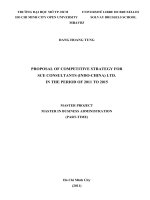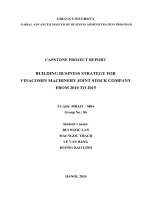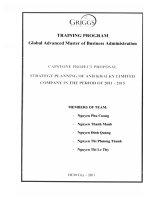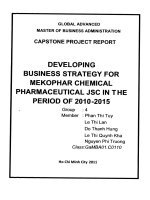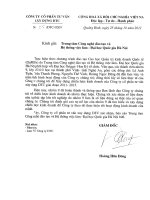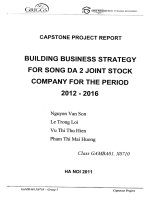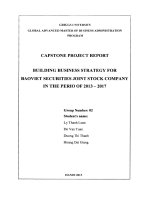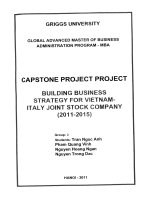Building business strategy for Gianh River Cosevco Cement Company within the period of 2010 -2015
Bạn đang xem bản rút gọn của tài liệu. Xem và tải ngay bản đầy đủ của tài liệu tại đây (868.64 KB, 75 trang )
University Griggs
Global Advanced Master of Business Administration
Capstone project report - Group: 04 - Class: GeMBA 01.V02
1
GOLBAL EXECUTIVE MASTER OF BUSINESS ADMINISTRATION
PROGRAM
CAPSTON PROJECT REPORT
Topic: Building business strategy for Gianh River Cosevco
Cement Company within the period of 2010 -2015
Group members:
1. Nguyễn Văn Hệ
2. Đậu Thành Trung
3. Nguyễn Thị Ngọc Thủy
4. Lê Thị Minh Phúc
5. Đoàn Kim Nga
University Griggs
Global Advanced Master of Business Administration
Capstone project report - Group: 04 - Class: GeMBA 01.V02
2
`TABLE OF CONTENTS
Page
List of abbreviations 5
List of tables, figures, diagrams 6
PREFACE 7
1. The need of study 7
2. Study targets 7
3. Study object 8
4. Study scope 8
5. Study method 8
6. Study significance 8
7. Assignment structure 8
CHAPTER I 9
1.1 Common knowledge of business strategy 9
1.1.1 Definition 9
1.1.2 Role 9
1.2 Process of building business strategy 9
1.2.1 Define vision and mission 9
1.2.2 Analysis of external environment 10
1.2.3 Analysis within enterprise 11
1.2.4 Analysis of strategy and choice 11
1.3 Some analysis tools 12
1.3.1 SWOT matrix 12
1.3.2 SPACE matrix 14
1.3.3 IE matrix 15
CHAPTER II: ANALYSIS OF BUSINESS ENVIRONMENT OF COMPANY 18
2.1 Introduction of company 18
2.1.1 Formation and development 18
2.1.2 Duties 19
University Griggs
Global Advanced Master of Business Administration
Capstone project report - Group: 04 - Class: GeMBA 01.V02
3
2.1.3 Machine organization 19
2.1.4. Business situation 19
2.2. Analysis of external environment 21
2.2.1 Macro environment 21
2.2.1.1 Economy 21
2.2.1.2 Politics - law 25
2.2.1.3 Natural conditions 27
2.2.1.4 Culture and society 27
2.2.1.5 Technology products 28
2.2.2 Sector environment 28
2.2.2.1 Providers 28
2.2.2.2 Customers 29
2.2.2.3 Potential competitors 30
2.2.2.4 Replaced product 31
2.2.2.5 Competition among enterprises within the market 31
2.3 Analysis of internal environment 34
2.3.1 Analysis of human resource 34
2.3.2 Analysis of strengths and weaknesses 47
CHAPTER III: BUILDING BUSINESS STRATEGY BY 2015 50
3.1Target 50
3.2 Strategy construction 50
3.2.1 Build up strategic alternatives 50
3.2.2 General choice of strategy 53
3.3 Strategy choice 60
3.4 Solution to implement strategies 60
3.4.1 Stable penetration into current market 60
3.4.2 Low cost 63
3.4.3 Solution of stable input materials 67
CONCLUSION 70
University Griggs
Global Advanced Master of Business Administration
Capstone project report - Group: 04 - Class: GeMBA 01.V02
4
REFERENCES 71
APPENDIX 72
University Griggs
Global Advanced Master of Business Administration
Capstone project report - Group: 04 - Class: GeMBA 01.V02
5
LIST OF ABBREVIATIONS
1. CA : Competitive Advantage
2. CHLB: federal republic
3. Công ty xi măng Cosevco Sông Gianh: Cosevco Gianh River Cement
Company
4. EFE: Exnternal Factor Evaluation Matrix
5. ES : Environment Stability
6. FS : Financials Strengths
7. IE : Internal – External Matrix;
8. IFE: Internal Factor Evaluation Matrix
9. IS : Internals Strengths
10. Km: Kilometer
11. SBU: Strategy Business Unit
12. SPACE: Strategic Position & Action Evaluation matrix
13. SWOT: Strength, Weakness, Opportunities, Threats
University Griggs
Global Advanced Master of Business Administration
Capstone project report - Group: 04 - Class: GeMBA 01.V02
6
LIST OF TABLE, FIGURE, DIAGRAM
NO.
Table
Page
1
Table 1.1: SWOT matrix
13
2
Chart 1.1 : SPACE matrix
14
3
Table 1.2: Total importance point in IE matrix
15
4
Table 1.3: Table of external factors matrix
16
5
Table 1.4: Table of internal factors matrix
17
6
Table 2.1: Business and production results within 2007- 2009
20
7
Chart 2.1: GDP and CPI growth via years
23
8
Chart 2.2: Predict consumption demand and growth rate of Cement
period within 2005 – 2020
24
9
Table 2.2: External factors evaluation
33
10
Table 2.3: Labor situation of the company in 2009
34
11
Table 2.4: Balance sheet - on 31/12/2009
37
12
Table 2.5: financial norms of Gianh river company in 2009
39
13
Table 2.6: sale price of Gianh river cement and some other kinds
of cement within the market in 2009
43
14
Table 2.7: IFE matrix
48
15
Table 3.1: alternatives to construct strategy (SWOT)
51
16
Table 3.2: factors of SPACE matrix
56
17
Table 3.3: IE matrix
58
18
Table 3.4: select some strategies
58
University Griggs
Global Advanced Master of Business Administration
Capstone project report - Group: 04 - Class: GeMBA 01.V02
7
PREFACE
1. The need of study topic:
Cement is the important materials in construction. Due to national socio-
economic development requirement, construction is more and more developed,
therefore cement demand is very high. Grasping such demand, together with State’s
supporting, domestic and foreign enterprises have focused on investing and
constructing many cement factories. Viet Nam cement corporation has predicted
situation of redundant cement compared to requirements, as follows: in 2010, it will
get redundancy of 4.96 million tons, in 2011 redundancy of 5.76 million tons, in
2015 redundancy of 4.62 million tons. Besides, in integration trend with the role of
member of WTO, Viet Nam must implement commitments of WTO in trading, non-
tariff and tariff barriers are removed, which has created good condition for foreign
commodity penetrated in Vietnam market, including cement. Therefore, it has
created violent competition among cement producing and selling enterprises in
current period. These enterprises must analyze reality of unit to find out strengths,
weaknesses, opportunities to promote and exploit to exist and develop in such
current competitive market; it means enterprise must build up business strategy to
have suitable steps in its own development.
Gianh River cement company is the unit which is newly established and has
operated since 8/2006. Therefore, in such background, trading activities must cope
with many difficulties. In order to develop trading activities unshakably, company
must have a trading strategy. Originated from realistic requirements, our group has
chosen the topic “Building business strategy of Cosevco Gianh River Cement
Company for the period of 2010 – 2015 ”.
2. Study purposes:
Based on study on theory of business strategy, then we can apply business
strategy of Cosevco Gianh River Company for the period of 2010 – 2015, to have
suitable orientations to adjust limitations, weaknesses, avoid threatens, promote
University Griggs
Global Advanced Master of Business Administration
Capstone project report - Group: 04 - Class: GeMBA 01.V02
8
strengths, focus ON resources, then maintain and stably develop trading activities
of company.
3. Study object:
Study, analyze factors which impact on trading and production of enterprise
in current situation, define development orientation for company in coming time.
4. Study scope
Related factors of business strategy of company via collected data in three
recent years (in 2007, 2008, 2009) and six beginning months of the year 2010.
5. Study method:
Method of data collection: via reports on trading results, report on resources
situation, materials of distributors, customers, partners, related information on
newspaper, website…; collecting data via observation, interview of experts, leaders.
…
Method of statistical analysis, synthesis, comparison, prediction and analysis
of matrix: SWOT, SPACE, EFE, IFE.
6. Study significances:
Study process will help learners to apply learned knowledge into reality,
supplement and prove scientific quality of learned theory. Study results are the
reference basis for company to choose suitable business strategy, which can ensure
sustainable and long term development.
7. Assignment structure:
Chapter 1: Theory basis of building business strategy
Chapter 2: Analyze business environment and company
Chapter 3: Build up business strategy.
University Griggs
Global Advanced Master of Business Administration
Capstone project report - Group: 04 - Class: GeMBA 01.V02
9
CHAPTER I: THEORY BASIS OF BUSINESS STRATEGY
1.1 Common theory of business strategy
1.1.1 Definition:
Business strategy is an art in designing, organizing medium to reach long
term targets of enterprise and have relation with the change of business environment
and competition.
Business strategy can define clearly basic targets and business orientation of
enterprise in each period which can ensure enterprise to develop constantly and
firmly in constant variable business environment. It can create thinking instruction
frame for action which is applied for a long time from 3 to 10 years and analyzed
constantly and expressed the thought of attack and win in business environment.
Normal business strategy is defined by three levels: company level; business
level and function level.
1.1.2 The role
It can help enterprise to realize clearly purposes and orientation. These will
be the basis, guidelines for all business activities of enterprise;
Raise effect of using resources, increase competitive position, ensure
sustainable development of enterprise.
Create firm basis for suggestions of policy and decisions on production and
trading suitable to market activities.
It can help enterprise to be active in grasping and exploiting business opportunities,
simultaneously proposing business method to overcome threatens and risk in
competitive market.
1.2 Process to build up business strategy
Building business strategy is the first period in strategic administration
process. This process include 4 steps:
1.2.1 Define mission and targets
University Griggs
Global Advanced Master of Business Administration
Capstone project report - Group: 04 - Class: GeMBA 01.V02
10
This is the first step of the process to build up strategy; mission and targets of
organization can provide a background to build up strategy.
Business mission of an organization is the purpose of business activities
which is the reason for the appearance, existence and development of an
organization. Business mission of organization can answer the question: for what
does organization appear and exist?
Targets are status, results that organization wants to reach in a defined time;
most of organization follows profit, target to reach the leading position. The second
targets are the ones that organization will consider if they want to reach outstanding
capacity.
1.2.2 Analysis of external environment
The second division of strategic administration process is to analyze external
environment of organization; Target of external analysis is to be aware of
opportunities and threatens from external environment of organization; three types
of external environment can have mutual relation including: sector environment is
the one in which organizations operate, national environment and macro
environment.
Analysis of sector environment needs the assessment of competitive structure
in the sector, including competitive position of centre organization and main
competitors as well as period of sector development. Many current markets have
become global market; analysis of sector environment can assess impact of
globalization in competition within a sector; sector environment (macro
environment) including: competitive opponents, providers, potential opponents,
replaced products.
Analysis of national environment is to consider whether the background in
which company is operating can create good condition to occupy competitiveness in
global market or not. If not, then company can consider transferring a part of
activities to nation with favorable background for reaching competitive advantages.
Analysis of macro-environment including consideration of macro economic factor
University Griggs
Global Advanced Master of Business Administration
Capstone project report - Group: 04 - Class: GeMBA 01.V02
11
(inflate rate, bank interest, policy of currency and finance …), political and legal
environment (political stability, labour law, tax policy …), social and cultural
environment (population, custom, tradition …), natural environment (problem of
environmental pollution, influence of geographical condition, lack of energy….),
technological environment (discover new technology, rate of technological transfer,
market of technological products …).
Analysis of external factors will allow enterprises to realize what opportunity
that enterprises can exploit and what challenge that enterprise must cope with.
Assessment of opportunities and threatens from external environment can help
enterprise build up clear business duty and find out suitable policies to reach targets.
Researchers have given EFE matrix to assess external factors.
1.2.3 Analysis within enterprise
Internal analysis is the third division of strategy administration process, to
find out strengths, weaknesses; methods to reach competitive advantage and the role
of different capacity (distinctive power of company), resources and capacity to
create and maintain competitive advantage of company; such conclusion can create
and maintain competitive advantage then company must reach effect, quality,
improvement and duty with customers; Power of company can put it in dominance
in this field on the contrary, weaknesses can give less effect.
Situation of enterprise will be analyzed based on functional activities such as
: financial situation; human resource; management; organizational structure;
development study; informatics technology.
Internal analysis of enterprise can allow realizing strengths and weaknesses
of enterprise then we can build up strategies to promote strengths and limit
weaknesses of enterprise.
Researchers have given IFE matrix to assess internal factors.
1.2.4 Analysis of strategies and choice
The next task is to define strategic method equivalent to strengths,
weaknesses, opportunities, threatens of company. Comparison of strengths,
University Griggs
Global Advanced Master of Business Administration
Capstone project report - Group: 04 - Class: GeMBA 01.V02
12
weaknesses, opportunities, threatens is called SWOT analysis. Basic purpose of
SWOT analysis is to realize strategies that it orient, create suitability or equivalent
among resources and capacity of company with environmental demand in which
company is operating; according to current schools of strategic administration, this
period must go further in realizing essence of competitive position based on
analysis to find out resources, capacity and essential ability for development of
choices.
Organization must assess many alternatives equivalent to capacity to reach
targets; strategic alternatives which are create can be included in level of business
unit, function level, company level or global strategy which allows to exist in the
most suitable way with fast change of global competitive environment as a feature
of most of modern sector.
1.3 Some tools to analyze strategy
1.3.1 SWOT matrix:
SWOT matrix can help us to develop 04 types of strategies:
- Strategies of strengths - Opportunities (SO)
- Strategies of weaknesses – opportunities (WO)
- Strategies of strengths-threatens (ST)
- Strategies of weaknesses – threatens (WT)
Purpose of SWOT matrix is to find out feasible strategies, which can be
chosen based on analysis, combination between internal and external environments,
which cannot decide which the best way is; therefore, in development strategies in
SWOT matrix, some best strategies are chosen to implement.
Strengths and weaknesses often originate within your organization,
opportunities and threatens are often related to external factors. Therefore, we can
consider SWOT as an important tool with highly general vision of organization. It
can help leaders to define market in sustainable way and consider all opportunities
that enterprise can make use of. By understanding weaknesses of enterprise in
business, managers can manage and remove risks in enterprise; moreover, by using
University Griggs
Global Advanced Master of Business Administration
Capstone project report - Group: 04 - Class: GeMBA 01.V02
13
comparison basis and SWOT analysis between enterprise and competitive
opponents, leaders can draft a strategy that can help enterprise to compete
effectively within the market.
Table1. SWOT matrix
SWOT
Opportunities: list
opportunities by
importance order:
O1
O2…
Threats: list threatens by
importance order:
T1
T2…
Strengths : list strengths
by importance order:
:
S1
S2…
SO strategy: use strengths
to exploit opportunities
SO1
SO2…
ST strategy: use
strengths to avoid
threatens
ST1
ST2…
Weaknesses: list
weaknesses by
importance order:
W1
W2…
…
WO strategy: limit
weaknesses to exploit
opportunities:
WO1
WO2 …
…
WT strategy: minimize
threatens and avoid
threatens
WT1
WT2…
Analysis quality of SWOT model depends on quality of collected
information. Therefore, we must avoid subjective view from one side by looking for
information from all sides: director board, customers, partners, providers, strategic
University Griggs
Global Advanced Master of Business Administration
Capstone project report - Group: 04 - Class: GeMBA 01.V02
14
partners, consultancy… SWOT can be also limited when arranging information
according to reduction trend, which can make some information be limited into
unsuitable position with essence of problems; many items can be neutralized or
mistaken between two extremes S-W and O-T due to viewpoints of analysts.
1.3.2 SPACE matrix
SPACE matrix has shown an enterprise to choose strategy: attack, cautious,
defense or competition; axis of matrix can have the following significances:
- FS : Financials Strengths
- CA : Competitive Advantage
- ES : Enviroment Stability
- IS : Internals Strengths
- Position of square 1: position is really favorable, using attack strategy to
penetrate into the market, develop product, combine rearward and front
combination.
- Position of square 2: using cautious strategy: penetrate into market, develop
market, diversify mixture (trading opportunity with enough resources and favorable
condition ).
Cautious
Attack
Defense
Competition
FS
+4
+3
+2
+1
0
0
+1
+2
+3
+4
CA
IS
-4 -3 -2 -
1
+1 +2 +3 +4
University Griggs
Global Advanced Master of Business Administration
Capstone project report - Group: 04 - Class: GeMBA 01.V02
15
- Position of square 3: using defense strategy such as: limit, remove,
liquidate and diversify mixture.
- Position of square 4: using growth strategy such as: combine rearward and
front combination horizontally, penetrate into market, market development (by
competition of cost, difference of products), develop products and joint venture.
1.3.3 IE matrix
Matrix of internal and external factors ( IE)
IE ( Internal – External Matrix) can set different SBU of an enterprise in
square a table of 09 squares. Such matrix can be based on 02 main aspects :
- Total importance point of IFE indicated on X axis
- Total importance point of EFE indicated on Y axis
- Each SBU must be established for IFE and EFE matrix, based on such basis
for IE matrix of company
- X axis can express total importance point of IFE matrix
If total points from 1.0 – 1.99 then it is internal weakness
If total points from 2.0 – 2.99 then it is average
If total points from 3.0 – 4.0 then it is strong
- Y axis can express total importance point of EFE matrix, out of which:
If total point is from 1.0 – 1.99 then it is low
If total point is from 2.0 – 2.99 then it is average
If total point is from 3.0 – 4 then it is strong
Table 1.2. Total importance point in IE matrix
Total importance point of IFE
matrix
Strong
3.0 – 4.0
Average :
2.0 – 2.99
Low
1.0 – 1.99
Total
importance
point of EFE
matrix
Strong 3.0 –
4.0
I
II
III
Average : 2.0 –
2.99
IV
V
VI
Low 1.0 – 1.99
VII
VIII
IX
University Griggs
Global Advanced Master of Business Administration
Capstone project report - Group: 04 - Class: GeMBA 01.V02
16
+ If a SBU located in squares of II, II, IV : should be developed and
constructed
+ If a SBU located in squares of III,V,VII : should be held and maintained
+ If a SBU located in squares of VI,VIII,IX : should be harvested or removed
1.3.3.1 Matrix for external factors evaluation
After analyzing opportunities and threatens arisen from external
environment, we can use EFE matrix to summarize and assess influence of such
factors on the enterprise. Development process of an EFE matrix including five
steps:
Step 1: List important factors for the success of enterprise.
Step 2: define importance from 0,0 (unimportant) to 1,0 (very important) for
each factor. Total classifying level is 1,0.
Step 3: classify from 1 to 4 for each factor to see the method that current
strategies of enterprise reacts to such factors out of which 4 indicates good reaction,
3 indicates above average reaction, 2 indicates average reaction and 1 indicates bad
reaction.
Step 4: multiple importance of each factor with its classification to define
importance point.
Step 5: accumulate importance point of factors to define total importance
point of each enterprise
Table 1.3: EFE matrix
Main external factors
Importance level
Classification
Importance point
Total
1.0
The highest importance point of an enterprise can be 4,0 and the lowest 1,0.
Total importance point is 4 which shows that enterprise has good reaction with
current opportunities and threatens in the environment. In other words, strategies
that enterprise uses can bring high effect from current opportunities and minimize
University Griggs
Global Advanced Master of Business Administration
Capstone project report - Group: 04 - Class: GeMBA 01.V02
17
negative influences of external threatens; total point is 1 which shows that strategies
that enterprise recommends cannot make use of opportunities and avoid external
threatens.
1.3.3.2. IFE matrix
Using IFE matrix to summarize analysis, evaluate strengths, weaknesses of
factors impacting on internal activities of enterprise. The development process of an
IFE matrix is similar to EFE matrix which is just different in step 3: mark 1 for the
biggest weakness, mark 2 for the smallest weakness, mark 3 for smallest strengths
and mark 4 for the biggest strengths.
Table 1.4: IFE table
Main internal factors
Importance level
Classification
Importance point
Total
1.0
Regardless of IFE matrix having how many factors, total importance point
can be classified from the lowest as 1,0 to the highest as 4,0. If total importance
point is lower than 2,5, it shows that enterprise is weak internally and if it is higher
than 2,5, it shows that enterprise is strong internally.
University Griggs
Global Advanced Master of Business Administration
Capstone project report - Group: 04 - Class: GeMBA 01.V02
18
CHAPTER II: ANALYSIS OF BUSINESS ENVIRONMENT OF
COMPANY
2.1 Company introduction
2.1.1 Formation and development of company
Cosevco Gianh River Cement company is the member unit depending on
Central Construction Corporation, which is established from Gianh River cement
factory of Quang Binh province with private stamp and account suitable to payment
form; Company is organized and operated according to organizational charter and
corporation’s activities and charter of company approved by administration council
corporation.
Name: GIANH RIVER
COSEVCO CEMENT COMPANY
Abbreviated name: GIANH RIVER
COSEVCO
It is located in Tien Hoa
commune, Tuyen Hoa district, Quang
Binh province.
Project to construct Gianh River
Cement factory – Quang Binh province is approved by Prime Minister in Decision
No.509/QĐ-TTg on 24/04/2001, is invested by Central Construction Corporation
with total invested capital of 2,.877 billion dong Viet Nam, equivalent to 201.23
million USD (construction reality of nearly 3,200 billion VND, equivalent to 203
million USD). Place for building factory in Tien Hoa commune, Tuyen Hoa district,
Quang Binh province, on the area of 33 ha. Designed capacity is 4.000 tons
Clinke/day, equivalent to 1.455 million tons/year (1,275,000 tons cement and
225,000 tons clinke), main products are: cement of PCB-30, PCB-400, PC-40, PC-
50 according to Vietnamese and international standards which can ensure
consumption quality within the country and export.
University Griggs
Global Advanced Master of Business Administration
Capstone project report - Group: 04 - Class: GeMBA 01.V02
19
Factory had ground breaking on 13/01/2002. Via a time of preparation of
financial investment procedure, factory has officially begun to be built on
05/7/2003. After three years of implementation, until 04/6/2006 the factory began to
produce the first Clinke of cement, then produce cement products.
To manage and put factory into production, on 25/6/2005 administration
council of Central Construction Corporation had promulgated Decision No.
234/QĐ-TCT-HĐQT, to establish Gianh River Cosevco Cement company directly
under the Corporation. In August/2006, management board of Gianh River Cement
factory project has assigned factory to Gianh River Cosevco Cement company to
manage operation.
2.1.2 Duties.
Based on Decision No. 234/QĐ-TCT-HĐQT on 25/6/2005 of Central
Construction Corporation and Business Registration Certificate No. 2916000026
issued by Quang Binh Department for Planning and Investment with the following
trading sectors:
- Exploit, process minerals to serve cement production;
- Produce and trading cements and Clinker, cement products;
- Trade in goods transportation;
- Trading cement packaging and implement other tasks assigned by
corporation.
2.1.3 Organizational structure.
Total labors of company are nearly 800 managers and workers.
Organizational structure has 10 divisions and 6 workshops. Company’s activities
are under direct management of Director; divisions and workshops have strong
relation with each other, ensure implementation of assigned tasks.
Besides, company has system of political organizations: party’s organization,
trade union, youth union, professional cadres for political organization.
Diagram of organizational structure in appendix 1
2.1.4 Situation and trading results.
University Griggs
Global Advanced Master of Business Administration
Capstone project report - Group: 04 - Class: GeMBA 01.V02
20
After the factory officially began to produce and sell products to the market
since 8/2006, company has coped with a lot of difficulties which can impact on
business results of company such as: insufficient cadres, global economic crisis,
natural calamity and flood (Storm No. 02/2007 has damaged total asset of 15 billion
and storm No. 05/2007 has collapsed conveyor belt, damage value of about 20
billion, delayed seaway activities), capital mobilization is insufficient, power supply
of factory is not stable; financial management of corporation (Financial Decisions
must have opinions of corporation)
However, leading board of company has focused on difficulties adjustment
together with provincial supporting and support of related partners then trading
results of company in recent time have increased constantly with rather high
increase density.
Annual revenue increase more than 30%, production and consumption
quantity have increased quickly, until the year of 2009 it has produced 946,381 tons
cement and 328,332 tons clinker (equivalent to 1.209046 tons cement) which
reaches 83,1% designed capacity, especially density of cement has increased
strongly, in 2009 it has increased 2.08 times compared to 2007.
Table 2.1. Results of business activities during 2007-2009
No.
Norms
Unit
2007
2008
2009
Comparison rate
(%)
2008/07
2009/08
1
Total revenue
Billion
dong
606.41
834.04
1,022.78
137.54
122.63
2
Produced
products
Tons
918,894
1,198,118
1,274,713
130.38
106.39
- Clinker
Tons
464,202
441,523
328,332
95.11
74.36
- cement
Tons
454,692
756,595
946,381
166.40
125.08
3
Consumed
Tons
1,047,417
1,145,769
1,306,921
109.39
114.06
University Griggs
Global Advanced Master of Business Administration
Capstone project report - Group: 04 - Class: GeMBA 01.V02
21
products
- Clinker
Tons
576,600
398,196
345,478
69.06
86.76
- cement
Tons
470,817
747,573
961,443
158.78
128.61
4
Labors
People
789
777
778
98.48
100.13
5
Average income
1000
dong/month
2,000
2,250
3,400
112.50
151.11
6
Budget payment
Billion
dong
35.60
44.87
47.50
126.04
105.86
7
Profit
Billion
dong
- 86.043
- 239.85
- 59.47
- 78.76
+ 75.2
(Source: report data of company)
In 2007 budget payment was 35.6 billion dong and until the year of 2009
company has paid budget of 47.5 billion dong, increased 33.43% compared to 2007,
which ranks the second in paying tax for provincial budget; company has solved
employment for nearly 800 direct labors in the province, annual average income
increases strongly from 2 million/month in 2007, until the year of 2009 it was
3,400,000 dong/month; well implement all policy and regulations of labors: social
insurance, medical insurance, periodic healthy examination, labor protectionism,
poisonous and other welfares. Besides, it has created employment for hundreds of
indirect labors within the area. By 31/12/2009 company has paid original debt of
539.128 billion dong, paid interest of 526.926 billion dong.
Consumption market of products is more and more expanded; until now the
market has expanded from Nghe An province to Ho Chi Minh city; out of which
main market from Ha Tinh province to Quang Ngai province, with distributor
quantity of cement in 2009 of 46. Therefore, in 2009 it has consumed 961,443 tons
cement and 345,478 tons clinker (equivalent to 1,237,825 tons cement (equal to
85,1% production capacity).
However, trading results still get loss, but loss has been reduced, as follows:
in 2009 loss has reduced 52.75% compared to 2008.
University Griggs
Global Advanced Master of Business Administration
Capstone project report - Group: 04 - Class: GeMBA 01.V02
22
The reason for loss is due to production which cannot reach designed
capacity (constant power-cut) then depreciation in price is still high (occupy high
density of 18.4%), besides lending interest occupies high density in price ( 19.9%);
transportation cost for product consumption ( 9.17%), meanwhile in term of
seaway, due to undredged narrow passage of Gianh river then big ship (1,000 tons)
cannot come to Len Bang port, just ship of 500 tons can enter. Besides, Hon La port
has implemented investment slowly then company must transfer to Vung Ang port
to transport products to market area II and III, therefore it has arisen cost of 10
billion dong/year which is also to increase cost.
It is expected by 2010, company will have breakeven capital and from later
years it will get profit; this is assessed in feasible project when making project to
build factory.
2.2. Analysis of external environment
2.2.1 Macro environment:
2.2.1.1 Economy:
In recent years, with the policy to develop economy in the right, our nation
has reached good results; economic growth rate of Viet Nam is rather high and
sustainable: GDP in 2005 it reached 8.4%, in 2006 it reached 8.17%, in 2007 it
reached 8.48%, in 2008 it reached 6.18% and in 2009 it reached 5.32%/.
Economic experts have supposed that after overcoming economic crisis,
economic growth rate of Vietnam in 2010 will be 6.l8% and continue to maintain in
the level of 7%-8%/year in coming years which can be completely feasible. Based
on stable development of economy, together with fast urbanization rate, cities and
towns, new towns have been built, housing market has been developed. According
to data of Construction Ministry, Vietnamese urbanization rate has increased
strongly; it is expected that in 2010 it will increase 33% and by 2025 it will increase
45%. Therefore, in the coming years, demand of cement and cement products is
high. This can be a good opportunity for cement factories
University Griggs
Global Advanced Master of Business Administration
Capstone project report - Group: 04 - Class: GeMBA 01.V02
23
21,67
6
7,32
6,8
5,1
5,32
8,48
8,17
8,4
6,18
0
5
10
15
20
25
2005 2006 2007 2008 2009
CPI GDP
Chart 2.1: Growth of GDP and CPI via years (source: statistical agency).
Besides, from Jan 2007, Vietnam has officially become a member of WTO;
such important event can give Vietnam both opportunities and threatens. Cement
sector is not out of such impact. Apart from opportunities such as: approach many
capitals, modern technology and management qualification…cement sector must
cope with violent competition of imported Clinke, cement and cement products
from China, India, Thailand…
According to estimation, cement consumption quantity in the year of 2010 of
Vietnam has reached 50 - 51 million ton, increased above 11% compared to 2009.
Vietnam cement corporation has predicted in the coming years, although cement
demand has increased with high rate of 11%/year by 2015, with capacity of cement
factories project, supply of cement will be redundant. However, to adjust above
difficulties, related ministry and sector have made consultancy to Prime Minister to
promulgate solutions to reduce supply and increase demand. Construction ministry
University Griggs
Global Advanced Master of Business Administration
Capstone project report - Group: 04 - Class: GeMBA 01.V02
24
has required provinces and cities not to issue investment certificate for new cement
projects; especially suggested Prime Minister to stop some projects in master plan
but slowly implemented with inconsiderable quantity, which is difficult to
implement. At the same time, use tariff and non – tariff tools to limit import of
cement products, priority for cement to replace other materials (construct road,
concrete…).
Chart 2.2. Expected consumption demand and growth rate of cement sector
during 2005 – 2020 ( source Ministry of industry and Commerce - cement – VCSC)
Gianh River cement company is the second factory of the province which
ranks the second in term of income and occupies a high density in provincial
industry; Cement sector is the first basis to create premise for developing provincial
industry; Therefore, Resolution of Provincial Party’s assembly, legislature XIV had
defined: focus on developing industries which can create motivation to promote
economic structure transfer. Out of which, it will give priority for industry of
material construction especially cement. This is an opportunity, good condition for
company to do trading activities.
Besides, together with common development of the nation, Northern Central
area has rather high economic growth rate compared to the whole nation with strong
urbanization. Especially, Government has currently focused resources on socio-
Consumption Demand
University Griggs
Global Advanced Master of Business Administration
Capstone project report - Group: 04 - Class: GeMBA 01.V02
25
economic development for this area; industrial zones, new urban centers, and
projects are constructed such as: Vung Ang industrial zone – Ha Tinh province,
Hon La economic zone – Quang Binh province, Chan May economic zone – Thua
Thien Hue province, construction of Southern Ha Tinh province – Northern Quang
Binh province by 2030 according to Decision No. 1685/QĐ-TTg on
14/9/2010…Therefore, demand of using cement and cement products in this area is
very high.
Interest factors:
After escaping from crisis, capital demand for trading of enterprises is very
high, interest for capital mobilization will increase (currently 9%/year). Therefore,
lending interest can increase which cannot be avoided; this is a big barriers for the
company in using capital.
Besides, input price of production materials has increased and tended to
increase (coal, power, Kraft…); this is the difficulty in promoting product price to
increase.
Exchange rate:
Exchange rate between domestic currency and foreign currency like USD
and EURO has changed according to orientation in which domestic currency loses
price; this is the good time for product export, but disadvantage for imported
products including cement, clinke and input materials to produce.
However, Gianh River cement company with the policy for diversification of
input material, main material in nation with high activeness then it will not depend
on import. Besides, company must improve techniques, do research to replace
imported equipments by domestic equipments, then when having the change of risk
on exchange rate, it will not impact much on trading activities of enterprise.
Then, domestic, foreign and provincial economic factors have shown Gianh
River company opportunities and threatens that must be estimated to have suitable
steps.
2.2.1.2 Politics-law:
